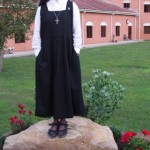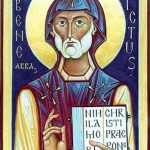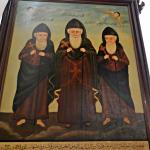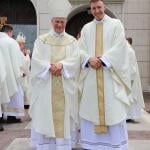Icon of St. Benedict, New Clairvaux Abbey, Vina, California
Written by a nun of St. Cecilia’s Abbey, Ryde, UK
I’ve long admired the website for the Benedictine Nuns at St. Cecilia’s Abbey in the Isle of Wight, UK, but it’s nice to see it highlighted and discover a lovely website in the bargain. Fr. Ray Blake quotes the Benedictines as to why they still chant the Liturgy of the Hours in Latin:
We made a deliberate choice to keep the rest in Latin for several reasons. First, the Gregorian Chant which we use for all our liturgy was composed for Latin texts. The melodies weren’t written first and then the words fitted to them; the melodies were made for the existing texts (almost all quotations from Scripture). We couldn’t use the same melodies for English words, and they’re so subtle and beautiful that to adapt them would be to spoil them. These chants evolved from the music of the synagogues which the first Christians adopted, and developed over more than a thousand years. There’s often a theology in the melody itself – for example, as it becomes more elaborate at the important words or phrases. Then, all the great monastic figures in the western Church wrote in Latin and it’s good to keep in touch with them. Often we’re singing chants which they would have known and prayed with just as we do. While Vatican II allowed the use of modern languages and modern music in the liturgy, it also insisted on the value of the Latin language and Gregorian Chant, and subsequent Popes have stressed that Benedictine monasteries have a particular duty and privilege to cherish and draw life from this wonderful spiritual heritage.
Near Ryde, which houses St. Cecilia, there is a monastery of monastic men, Quarr Abbey.
Beautiful pictures of both houses of prayer.











